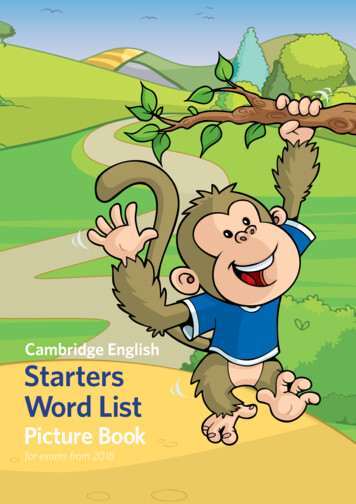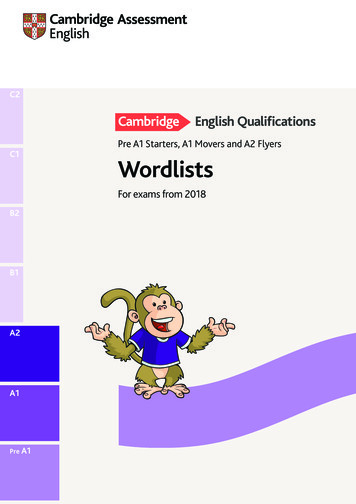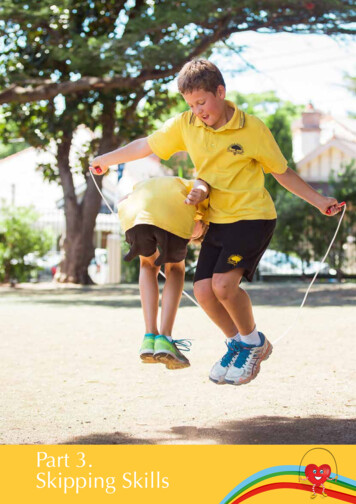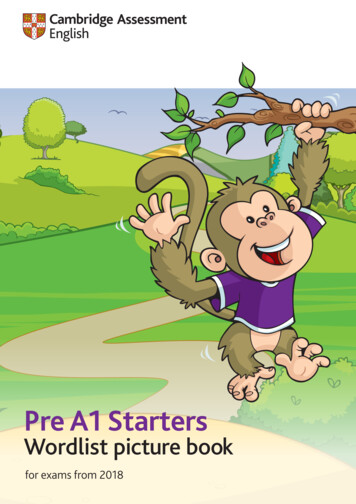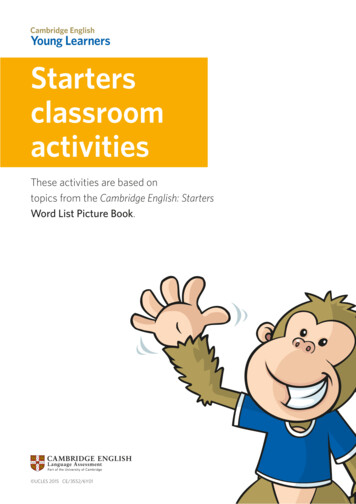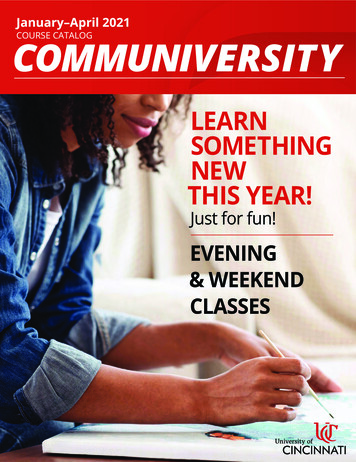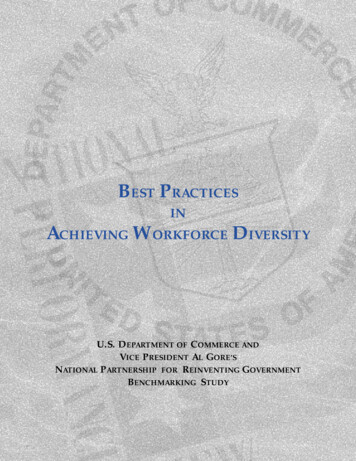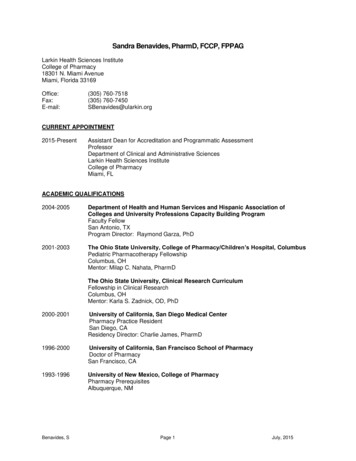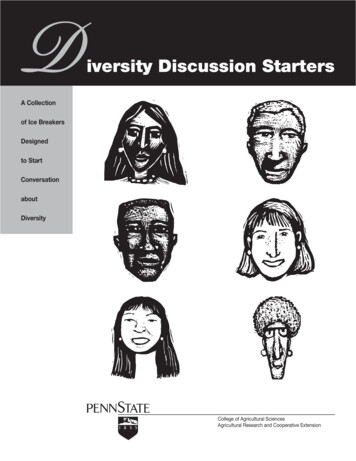
Transcription
Diversity Discussion StartersA Collectionof Ice BreakersDesignedto StartConversationaboutDiversityCollege of Agricultural SciencesAgricultural Research and Cooperative Extension
Contents23Introduction5Life Skills8Discussion Starter 1“Diversity”9Discussion Starter 2“The Man and the Eagle”10Discussion Starter 3“Color Blind”11Discussion Starter 4“Crayons”12Discussion Starter 5“The Crayon Box That Talked”14Discussion Starter 6“If All the Trees Were Oaks”15Discussion Starter 7“The Black Balloon”16Discussion Starter 8“The Cold Within”17Discussion Starter 9“A Cat & A Mouse”19Discussion Starter 10“Welcome to Holland”21Discussion Starter 11“Where Monsters Can Grow”22additional Resources/References23Life Skills Chart
IntroductionDiversity means differences and includes all ofus in our rich and infinite variety. Currently,technological advances are making communication around the world easier and faster. The U.S.population is undergoing demographic changes.As a result of these changes, diversity is moreprevalent in schools and in the workplace. Thesedemographic changes also create the need to implement multicultural educational experiences inboth formal and nonformal educational settings.As youth development leaders provide quality educational experiences for youth, utilizingcurricula that are inclusive of diversity educationtraining is important. We need to prepare youth(and people of all ages) to function and succeedin a diverse society and world.OverviewThis publication is designed to help facilitatediscussion about diversity among youth andadults. Diversity is discussed in a broad sense inthis publication through a variety of stories andpoems. Each story and poem is set up as an activity that includes a brief discussion and severalthought-provoking questions. These activitiescause youth and adults to think critically aboutthe meaning of diversity. This guide is also designed to help youth and adults value their owncultures as well as other people’s cultures and toreflect on the lives and perspectives of people whoare different from themselves.Goals of this GuideThis activity guide will help facilitate discussionabout diversity. The goals of this guide are:n To provide materials that will further promptdiscussion about diversity and related issues.n To offer thought-provoking questions regarding diversity for use with various audiences.3
How Can These Activities Boost anUnderstanding of Diversity?When and Where Should TheseActivities Be Used?Learning about diversity can be fun. However,beginning to discuss the topic of diversity can bedifficult. Therefore, this publication will provideactivities that can help participants:n Define and think about how they interpret theterm “diversity.”n Interpret the stories’ and poems’ meaning forthemselves.n Share their feelings regarding the stories andpoems.n Accept and respect differences and similaritiesbetween themselves and others.The materials and activities in this publication are appropriate for use by teachers, youthdevelopment leaders, diversity educators, childcare professionals, and education professionals in other settings. Although the materials inthis publication are appropriate for elementaryschool–age youth, many of the discussion startersare adaptable for use with people of a variety ofages. In fact, adults will benefit from engagingin thought-provoking discussions and questionsfound in this discussion guide. Select the questions that are most appropriate for the group.Adapting the materials for various audiences willbe left up to the facilitator’s discretion.This guide can be used a variety of ways. Thefacilitators may select the approach that best suitstheir groups’ needs. Facilitators should knowthat the activities in this guide should be used asdiscussion starters or icebreakers. However, manyactivities may serve as the basis for an entire lesson. In both cases, the facilitators should allowample time for discussion at the end of the activity. This will depend on the size of the group, thesetting, and the amount of time available. Thefacilitators must select the activities that fit theirgroups and their situations.Note to FacilitatorsDiscussion of unresolved feelings is importantfor clarification and dissolving any misunderstandings. Since discussing the topic of diversityoften leads to revealing personal information,participants need to feel comfortable when takingpart in these activities. These activities should beconducted in an environment that allows participants to feel comfortable with sharing.4
Life SkillsLearning and facilitating discussion about diversity isn’t all that will result from using this guide.This guide also allows participants the opportunity to practice skills that they will be able to usein real life.nnnThis section will explain the many skills participants will gain by working through the activitiesin this guide. The definition of each life skill hasbeen adapted from Targeting Life Skills, by Patricia A. Hendricks, former Iowa State extensionyouth development specialist. Life skills found inthis guide include:n Valuing Diversityn Thinking Criticallyn Learning to Learnn Problem Solvingn Cooperationn Caring for othersn Working in a teamn Decision Makingn CommunicationDefinition of Life SkillsValuing Diversity—recognizing and welcomingfactors that separate or distinguish one personfrom another. It also means being aware of themany similarities and differences among peopleand their cultures. In valuing diversity, one mustbe willing to accept that differences are okay andlearn to value one’s own uniqueness and “specialness.”Thinking Critically—can be thought of astalking things over with yourself in your mind,deciding what to think or do, and improving thequality of decision making. The critical-thinkingprocess can be stated as a set of questions you askand answer yourself.n Observing the situation carefully: Do I agreewith what is being said or done?Examining your reaction: How do I really feelabout what is being said or done?Considering alternative responses and opposing viewpoints: Based on what I know, is thestatement true?Deciding among the alternatives: What implication does this decision have on my futureand me? Am I willing to use this informationin making decisions?Learning to Learn—acquiring, evaluating, andusing information; understanding the methodsand skills for learning.n Observing or using the senses to gain new information or finding new ways to use information.n Understanding the meaning of the information.n Questioning to gain more information.n Using the learned information in new situations, to solve problems, or to change yourbehavior.n Being able to break down information intoparts.n Integrating parts of information to form awhole.n Judging the value of information for a givenpurpose.n Being able to communicate information tosomeone else.n Supporting the efforts of others to learn.Problem Solving—clearly identifying a problemand a plan of action for resolution of the problem. The problem-solving process involves thefollwing:1. Identifying/clearly defining the problem situation.2. Gathering information; considering priorities,resources, needs, and interests.3. Thinking of alternative solutions.4. Comparing and selecting the best alternatives.5
5. Planning a strategy—setting a goal and determining ways to reach that goal.6. Carrying out the plan—applying the solutionto the problem.Cooperation—working or acting together fora common purpose or mutual benefit. This includes the following skills:n Communicating effectivelyn Setting group goalsn Using social skillsn Interacting effectively with othersn Building and maintaining trustn Providing leadershipn Engaging in discussion and controversy thatproduces resultsn Managing conflictn Accepting responsibilityCaring for Others—showing understanding,kindness, and concern toward others; giving attention to the well-being of others.n Showing sensitivity to other’s situations andtheir well-being.n Being sympathetic; capacity for sharing or understanding the feelings of another; compassion.n Involving oneself in helping others; demonstrating concern.n Being able to accept expressions of concernfrom others.6Working in a Team—work done by two ormore people, each doing parts of the whole task.Teamwork involves:n Communicating effectively.n Identifying a common task.n Dividing a task by identifying contributionsby each person (roles).n Accepting responsibility for your part of thetask.n Coordinating the interaction (working together) to complete the task.n Sharing accomplishment.Decision Making—choosing among several alternatives. The decision-making process includes:1. Specifying goals and constraints (limits).2. Generating alternatives.3. Considering risks and appraising alternatives.4. Choosing an alternative to implement.Communication—exchanging thoughts, information, or messages between individuals; sendingand receiving information using speech writingand gestures. Messages must be sent and receivedfor communication to have taken place. Someexamples are:n Reading: considering ideas, thoughts, information, or messages that have been written.n Speaking: talking or verbal communication;conversation; planning, organizing, and presenting a speech.n Listening: hearing and interpreting verbal(spoken) communications.n Giving feedback: responding to communication.n Observing: being attentive to and interpreting nonverbal communication, such as bodylanguage and gestures.
Copyright Information and DisclaimerIn an effort to provide quality poems and stories,we diligently sought information on each of theworks. We, the creators of this activity guide,exhausted every possible avenue to find authorinformation and to gain permission for includingeach work. We want to ensure our work reflectsthe highest level of integrity and professionalism.All items are believed to be in the public domainunless otherwise noted. If you know that an itemdisplayed is not in the public domain, pleasenotify us with the publishing information. Uponverification, the item will be removed from thepublication unless permission to use it has beengranted by the author.7
Discussion Starter 1DiversityAuthor unknownThe second-grade school teacher posed a simpleenough problem to the class. “There are fourblackbirds sitting in a tree. You take a slingshotand shoot one of them. How many are left?”“Three,” answered the first 7-year-old boy withcertainty. “One subtracted from four leavesthree.”“Zero,” answered the second 7-year-old boy withequal certainty. “If you shoot one bird, the otherswill fly away.”DiscussionThe problem, as it turns out, was not so simpleafter all. In some ways it gets to the very heart ofwhat the fuss is all about regarding cultural diversity and the need to recognize, understand, value,and, finally, manage it.Questionsnnnnnnnn8Pretend you were in the class in the story.How would you have answered the teacher’squestion?Why do you think the two 7-year-old studentsanswered the question the way they did?Take a moment to think about what diversitymeans to you. Do you think it means the samething to other people?What’s the correct answer? Is there only oneway to answer the question?How do people’s perspectives play a role inhow they may answer the teacher’s question?Why do you suppose the first child answered,“Three,” while the second child answered,“Zero”?The author of this vignette illustrates the viewpoints of children who grew up in differentenvironments. What is the lesson the author istrying to present?Reflect on the story. Do you think birds canbe compared to human situations? Why orwhy not?
Discussion Starter 2The Man and the EagleQuestionsAuthor unknownnThere was once a man who had never seen aneagle. One day a magnificent eagle landed on hiswindowsill, and when he saw it, he exclaimed,“What an ugly creature!” The man grabbed theeagle and pulled it into his house. “First, I’mgoing to fix that curved beak of yours.” He useda file to remove the hook in the eagle’s beak.“Those claws are vicious looking,” the man saidas he clipped the eagle’s claws until there was little left. When he finished, the man said, “There,now you look better.” And he put the bird backon his open windowsill and shooed it away. Youcan imagine how long the newly trimmed eaglelasted in the wild.nnnnnnDiscussionThe man changed the bird drastically in thisstory. Without valuing the bird’s special qualities, the man altered the bird to what he thoughtwould be better. This story can be used to discussdiscrimination and the effect it has on those whoare discriminated against.nnnnnnThink about the eagle for a moment. Howimportant do you think it is for the eagle tohave its claws and sharp beak?Why are the eagle’s beak and claws importantto its survival?After reading this story, why do you think theman changed the bird?Did the man know the importance of theeagle’s claws and beak? If he knew more abouteagles, do you think he would have appreciated the eagle instead of changing it?Have you ever tried to change a person who isdifferent from you?Are some people cruel in this manner topeople with whom they are not familiar?Do you think it’s ethical to change peoplebecause you think their characteristics are different or somehow less superior to yours? If so,in what situation do you feel this is justified?What happens when people place their beliefson others?Can all people be judged by the same standardof beauty? Why or why not?In your opinion, what makes a person beautiful/attractive?What role does a person’s preference play indeciding what is beautiful or attractive?How do we treat people who don’t look likeus—have different skin colors; are taller, thinner, or heavier; have braces or glasses; use acane to walk; have wrinkles; are older, younger, deaf, or blind?How does this story parallel the history ofAmerica?9
Discussion Starter 3Color BlindClever BlackIf all of us were color blindI know it’s then we would findThat of the problems facing nationsThere’d not be one on race relations.The color of a fellow’s skinIs just on top, and very thinHe’s really just the same down under,But how we treat him makes me wonder.DiscussionJudging others by the color of their skin is a formof stereotyping. Look up this word in a dictionary and discuss any stereotypes you have as wellas ones others have made about you. Think aboutthe effect it had on you and on others.I asked a preacher—a nice fellowIf souls were black or white or yellow;He said he thought the soul of a manWas neither white, nor black, nor tan.QuestionsHe said he thought that it was true,From listening to a God he knewThat we would someday, somewhere findThat even Christ was color blind.nnnnnnnnnnnn10What do you think it means to be color blind?Do you believe it is possible to be colorblindin today’s society?What do the colors of people’s skins say aboutthem? Does it accurately describe their personality, intelligence, or ability?Why do people have different skin colors?Can you name a group of people who werepersecuted simply because of the color of theirskin?Have you ever made judgments about peoplebecause of the color of their skin? If so, whatdid you think? Did you realize you were making assumptions at the time? How did you feelafter making that assumption? Please shareyour experience(s).How do people’s upbringings affect theiracceptance of people who are different fromthemselves?Has anyone ever made an assumption aboutyou based on your race (physical attributes)?What do people’s skin colors mean to you?What does racial profiling mean?What effects do you think racial profiling willhave on those who are targeted? What aboutthose who do the profiling—are they wrong?Is racism the only reason nations fight? If not,what other reasons exist?
Discussion Starter 4CrayonsDiscussionAuthor unknownAppreciating diversity is valuing what makes ussimilar as well as different. This poem talks aboutlearning to live together and appreciating theunique qualities of others. Encourage participantsto look around themselves and take note of allthe things that make them who they are. Thispoem is special because it can be adapted to discuss all areas such as gender, age, physical abilities, intelligence levels, racial/ethnic backgrounds,economic status, beliefs, family structures, placesof residence, and so forth.We could learn a lot from crayons:Some are sharp,Some are pretty,Some are dull,Some have weird names,and are all different colors,But they all have to live in the same box.QuestionsHow are people similar to a box of crayons?n Have you met people who have distinct namesor talk differently than you do? How did youreact when you first met them? How did theyreact to you?n Do the ways people look indicate their levelof intelligence?n How can people with varying traditions, beliefs, and values learn to live together in thesame community? What would you expectto be the positive and negative about thattype of situation?n What if everyone in the world was exactly thesame? If they all looked the same, talked thesame, shared the same views, practices, andtraditions, what kind of world would it be?Do you think this would be a place you’d wantto live? Why or why not? Explain.11
Discussion Starter 5The Crayon Box That TalkedShane DeRolf, reprinted with permission from Random House, Inc.While walking in a toy store, the day before today,I overheard a crayon box with many things to say.“I don’t like red,” said Yellow. And Green said, “Nor do I.”And no one here likes Orange, but no one knows just why.“We are a box of crayons that doesn’t get along,”said Blue to all the others, “Something here is wrong!”Well, I bought that box of crayons, and took it home with me,And laid out all the crayons so the crayons could all see. . . .They watched me as I colored with Red and Blue and Green,and Black and White and Orange, and every color in between.They watched as Green became the grass and Blue became the sky.The Yellow sun was shinning bright on White clouds drifting by.Colors changing as they touched, becoming something new.They watched me as I colored. They watched me till I was through.And when I’d finally finished, I began to walk away.And as I did the crayon box had something more to say. . . .“I do like Red!” said YellowAnd Green said, “So do I!And, Blue, you were terrific,So high up in the sky!”We are a box of crayons,Each one of us is uniqueBut when we get together . . .The picture is complete.12
DiscussionThis is a vivid story about a box of crayons thatdid not get along. At first they disliked eachother, but after learning to value each other’sunique qualities, the crayons in the box beganto appreciate each other as they worked togetherto create a beautiful picture. Young children willrelate to these colorful characters. Use this carefully created story to promote open-mindednessand cooperation and to dispel stereotypes aboutdifferent groups of people.QuestionsnnnnnnnnnWhy didn’t the crayons in this box get along?Why did the little girl take the box of crayonshome?What did it take for the crayons to begin toappreciate each other?What were the benefits of the box of crayonsworking together?Are people sometimes like this box of crayons?In what ways do you think they are similar tothe box of crayons?Is the box of crayons similar to your classroom, club, or group? How is it similar? Howdoes it differ? Explain.Do you think this box of crayons becamemore open-minded toward each other? Werenew friendships formed?Each crayon had a unique quality that contributed to the picture. Think of two uniquequalities you have as an individual. Share themwith a partner or the group. Listen as yourpartner shares their qualities. Take note of anysimilar and/or different qualities that you andyour partner have.Pretend you and your friends were like thisbox of crayons. What would the picture thatyou color look like?13
Discussion Starter 6If All the Trees Were OaksDiscussionAuthor unknownThis poem paints a picture of how the worldwould be without diversity. Use this poem todiscuss the importance of valuing differences inpeople. Remember, the focus should be broadin scope—do not limit discussion to race issues.Expand dialogue to include physical disabilities;learning styles; places of residence: urban, rural,and suburban; rich, poor; age; gender; religion;morals, values, traditions, and more.What if all the trees were oaksHow plain the world would seem;No maple syrup, banana splits,And how would orange juice be?Wouldn’t it be a boring place,If all the people were the same;Just one color, just one language,Just one family name! But QuestionsnnIf the forest were the world,And all the people were the trees;Palm and pine, bamboo and willow,Live and grow in harmony.Aren’t you glad, my good friend,Different though we be;We are here to help each other,I learn from you, and you, from me.nnnnnnnHow is the forest like the world?The poem lists four different types of tree—palm, pine, bamboo, and willow. What aresome of the differences found in people? Makea list, then share it with others in the group.What would it be like if all your friends wereexactly the same? If they liked the same things,talked the same, and acted the same, wouldyou have as much fun with them?What would happen if all the people in theworld were the same? What kinds of traditions would exist? What holidays would wecelebrate? Which holidays would no longer becelebrated? How difficult would it be to decideon those important things? What would wegain and what would we lose?Do you think it is positive or negative thateveryone in the world is different? Explain.How important is it to learn from people whoare different from you?What kinds of things can you learn froma person who comes from another part ofthe country or a country outside the UnitedStates?How do our differences help each other andallow us to learn from each other?What are the benefits of diversity?
Discussion Starter 7The Black BalloonDiscussionAuthor unknownYoung people often look to trusted adults toprovide them guidance and clarity in life. Thispoem depicts a situation in which a young boywondered if the color of the balloon affected itsability to float away. This can be used to discusshow physical characteristics may or may not affect a person’s potential in life. As you facilitatediscussion be sure to talk about stereotyping andhow it too may affect a person.The little black boy watched a man,Blow up balloons one dayWhen each balloon was filled, the manLet each one float away.The little boy watched patiently,And waved each one good-byeAs all the pretty bright balloonsWent drifting toward the sky.He asked the man if black balloonsWould go up like the rest.The man said, “Son, I’ll blow one up,And put it to the test.’”And when the black balloon was filled,They watched it rise and glide.“It’s not the color, son,” he said,“But what you’ve got inside.”QuestionsnnnnnnnnnHow different were the balloons in the story?What did they all have in common?Why do you think this man was filling balloons and then letting them float high into thesky?What do you think made the boy ask aboutthe black balloon?Do the colors of people’s skins determine whothey are inside? What do the colors of people’sskins say about them?Does the color of your skin or a disabilitydictate your potential in life? Will it help orhinder your from accomplishing your dreamsand goals?Why do people make predetermined judgments about others? What should you dowhen people around you make judgmentsabout another person? How can you handlethe situation?Do you believe that our world judges peopleby their outside differences or the beautywithin?What lessons did the boy learn from thisencounter?What questions might the boy have followingthis encounter?15
Discussion Starter 8The Cold WithinDiscussionJames Patrick KinneyThis story depicts six humans brought togetherby a common happenstance. Each individualin the group sat silently, harboring prejudicesagainst the others in the group. In the end, thegroup perished because of their inability to getpast their negative views of others. This is apowerful story that can be used to show what canhappen when people hold prejudiced views.Six humans trapped by happenstancein bleak and bitter coldEach possessed a stick of wood,Or so the story’s told.Their dying fire in need of logs,the first woman held hers backFor on the faces around the fireShe noticed one was black.QuestionsnThe next man looking ’cross the waySaw one not of his churchAnd couldn’t bring himself to giveThe fire his stick of birch.The third one sat in tattered clothesHe gave his coat a hitch,Why should his log be put to useTo warm the idle rich?The rich man just sat back and thoughtOf the wealth he had in store,And how to keep what he had earnedFrom the lazy, shiftless poor.nnnnnnnnnThe black man’s face bespoke revengeAs the fire passed from his sight,For all he saw in his stick of woodWas a chance to spite the white.And the last man of this forlorn groupDid naught except for gain,Giving only to those who gaveWas how he played the game.16The logs held tight in death’s stilled handsWas proof of human sin.They didn’t die from the cold without,They died from the cold within.nnnHow do you think the six people in this poemdied? Why?Describe how this story made you feel.What is the fire a metaphor for in this story?Pick one character from this story. Describethe character.What surprised you about the characters inthis story?What assumption did each of the charactersmake about the others around the fire?What major effect did the characters’ opinionshave on their lives?What do you feel contributed to each person’sdecision not to share his or her log of wood?Do you think it is okay for people to act thisway? Why or why not?Have you ever shared any of the thoughts orbeliefs of the six characters?How do you think this story should haveended? If you could rewrite the ending of thisstory, would you? What would you changeand why?This poem presents the story of five men andone woman, each with their own prejudicethat inhibits rational thought. What wouldyou have done if you were trapped in the bleakand bitter cold with a dying fire and you had astick? Would you have hesitated to share yourstick of wood?Explain the last verse. What impact does thisverse have on the way you view others?
Discussion Starter 9A Cat & A MouseDiscussionDr. J. Norris & Dr. C. WhettenTexas A&M UniversityReprinted with permission 1999This story provides a vivid picture that will allowparticipants to imagine how the mouse feels before he is swallowed up by the cat. As businessesin the U.S. become more globally focused, theneed to prepare youth to be competitive in themarketplace is even more prevalent along withthe need to teach sensitivity. Use this story to discuss the importance of gaining marketable skillssuch as learning another language, other than anative tongue.The setting is a typical dockside scene in aforeign port somewhere in the world. The cat,rather than being a typical, scrawny, underfedspecimen, is well fed and powerful. The mouseis the typical, small, meek, desperate creaturewe would expect. The cat is chasing the mouse.The mouse is just about finished when he spiesa hole in the wall. In a last, desperate attempt hesprints and dives into the hole just ahead of thecat. With pounding heart and heaving lungs, hecannot believe that he is safe. As he begins to regain his composure, he begins to worry about hisimmediate future. He quickly sees that the holedoes not have another exit and he will have to goback out of the entrance. But he knows that thecat will be waiting for him. Suddenly, he hearsa dog barking just outside the hole . . . “Ruff!!Ruff!! Ruff!!” Now, the mouse begins to reasonthat dogs hate cats, and that cats are frightened ofdogs, and if there is a dog, then the cat must begone. Feeling extreme elation at his good fortune,the mouse saunters forth out of the hole only tobe grabbed up by the cat. As the cat dangles thebeaten mouse by his tail in preparation for a tastymorsel, the mouse in a plaintive, dejected voicesays, “But I don’t understand. I know I heard adog barking.” And the cat, with a sly grin spreading across his face, replies, “To be successful intoday’s world, one must be bilingual.”17
Questionsnnnnnnnnnn18Did the ending of the story surprise you? Whyor why not?Describe the cat’s special skill. How did sheuse it?What does it mean to be bilingual?What analogy does the “bilingual cat” apply tothe real world today?What are the benefits of being bilingual?How important is open-mindedness to experiencing other cultures and languages?Do you think students should be required tolearn another language in school? Why or whynot?What other skills are useful to have wheninteracting with people who speak anotherlanguage?Do people’s abilities to speak multiple languages increase their marketability in theworkplace?Explain why you agree or disagree that youhave to be bilingual to succeed in today’sworld.nnnnnnHave you ever been faced with an unusualproblem or situation that required you to use aspecific skill? What was the situation and whatskill(s) did you use?Write about a time when you’ve been in asituation similar to one of the characters. Howdid you get through it? What did you learn asa result?How important is it to learn other languages?Does it increase your chances of communicating with others? Explain. Do you find it to bea useful communication tool or skill?If you could rewrite the ending of this story,how would you change it?Who do you think the cat and the mouserepresent in our society?If the mouse in the story was deaf, how wouldthis story differ? What challenges would themouse face?
Discussion Starter 10Welcome to HollandEmily Perl Kingsley 1987 by Emily Perl KingsleyAll rights reservedI am often asked to describe the experience ofraising a child with a disability—to try to helppeople who have not sha
us in our rich and infinite variety. Currently, technological advances are making communica-tion around the world easier and faster. The U.S. population is undergoing demographic changes. As a result of these changes, diversity is more prevalent in schools and in the workplace. These demographic changes also create the need to im-
